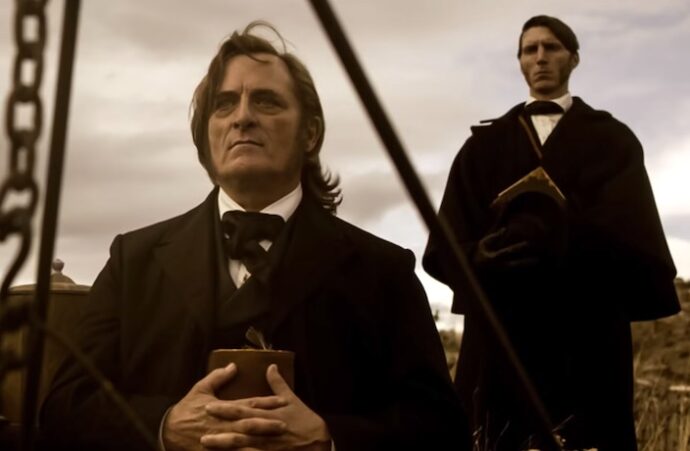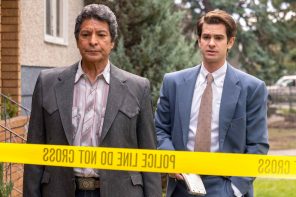The combination of breathtaking set-pieces and gripping narrative, coupled with strong acting and a substantial marketing blitz, has resulted in the series rocketing to the top of Netflix’s rankings in just its first week.
But although it draws from actual events and figures, historical accuracy is not among its strengths. Nor is it a goal. The flagrant disregard of well-established historical narratives regarding the Utah War of 1857-1858 makes this a work of fictionalized history rather than historical fiction. Indeed, creator Mark Smith and director Peter Berg are more interested in appropriating historical characters, events, and settings to tell a story of human depravity and base desires (and to shed copious amounts of blood along the way).
But while Smith and Berg successfully create a compelling saga, they perpetuate a misunderstanding of American colonization and miss a chance to explore an important lesson about democracy desperately needed in today’s moment.
The Utah War commenced with President James Buchanan ordering 2,500 troops in the spring of 1857 to quell what he called a “Mormon insurrection” in Utah territory. The Latter-day Saints—led by Brigham Young, president of the Church of Jesus Christ of Latter-day Saints and Utah’s territorial governor—were tired of being ruled by eastern politicians who questioned their loyalty. They demanded statehood and refused to acknowledge federally-appointed superiors. In sending an army, Buchanan was determined to reassert control by force.
In response, Young declared martial law and prepared his saints for war. Mormon leaders preached hellfire sermons that reaffirmed their animosity toward a government they believed had betrayed them, and they forged alliances with Indigenous communities to fight their common foe. Amid these heated conditions, Latter-day Saints in the southern part of the territory slaughtered a migrant train carrying men, women, and children.
While the attack was instigated by local clashes, it was enabled by the fiery rhetoric coming from Young and other LDS leaders. The loss of around one hundred innocent lives is one of the most horrid episodes of the era, and to make matters even worse Mormons quickly shifted blame to the Paiute, whom the saints claimed had orchestrated the travesty.
The massacre is depicted in American Primeval’s first episode, yet very little of the scene resembles history. This adaptation in fact softens the ordeal—the actual September 1857 event was far more sinister. Numerous consultants were hired to ensure the authenticity of the sets, clothing, and other cultural details—including a tour with LDS Church historian and noted expert Richard Turley—but Smith and Berg are consciously and flagrantly playing fast and loose with narrative details in an attempt to capture the spirit of the era rather than the letter.
It’s just that the spirit is also misleading.
While showrunners hope the audience will take away messages of “human triumph” and “the good that people are capable of,” this is an especially bleak portrayal of the American frontier. “There is only brutality here,” militia captain Lucas Neff reports to his superiors back East. American Primeval’s basic assumption is that when humanity is stripped down to its primitive—its primeval—roots, it is unapologetically irrational and violent. The few characters who break this mold are exceptions.
This argument fits into a traditional understanding of the colonization of the Western United States as a lawless land governed by passion rather than rule. Note the words in block letters that introduce the series: Utah Territory, 1857. Wild and Untamed. Such framing is familiar lore, but it’s also superficial. It reduces American imperialism to cowboy cosplay with only a few virtuous actors among a sea of irrational fanatics.
And, while nearly every group in American Primeval is reduced to uncivilized zealots, nobody comes out worse than the Latter-day Saints, whom one TV critic described as “Polite American ISIS.” Despite having downplayed the Mountain Meadows Massacre, Smith and Berg invent new episodes of Mormon violence; the so-called “saints” ambush an Army unit, enact several instances of extralegal murders, and even orchestrate a Shoshone massacre. (A real, and tragic, butchery of the Shoshone, the Bear River Massacre, was actually committed by federal troops during the Civil War.)
In the end, the show’s commitment to—and embellishment of—violence and gore embodies deeper problems. The Mountain Meadows Massacre was indeed one of the bloodiest episodes on the American frontier, but it was also the only major slaughter during the Utah War. No armed militias ever battled one another.
By the time federal troops made it to Salt Lake valley, politicians and delegates had negotiated a truce that avoided further mêlées. When the US Army marched into the city of saints—the long-dreaded moment of conflict—the entire town was empty, as LDS members had fled south. The crisis that commenced with threats had concluded with compromise. Not bullets or axes.
In turning the Utah War into an irrational thirst for blood, American Primeval not only perpetuates a myth of a lawless West, but it misunderstands the nature of the crisis itself. The conflict between Mormons, Natives, and the federal government was a contest over democracy: how could such divergent visions—of religion, of dominion, of humanity—fit under a single national umbrella? Latter-day Saints in Utah and politicians in Washington DC were nearly willing to go to war over that question’s implications. Indigenous representatives frequently petitioned for Native sovereignty and political representation. In the end, it was negotiation that solved the “Mormon crisis,” and legislative action that settled the “Indian Problem.” For better or worse, American sovereignty was extended—over Mormons, traders, and Natives—through federal imperialism, the majority overruling the minority.
We are once again living in a time when national politicians, fueled by populist support, are calling for both the colonization of land as well as the suppression of marginalized peoples. The spirit of “Manifest Destiny”—the rallying cry that led to expansion into the West—hasn’t disappeared, it’s merely been applied in different contexts. If we recast our understanding of the past, and forfeit the desire to depict colonizers as bloody primitives divorced from modernity, we might more easily recognize how, even today, this awful legacy continues to influence US policy. To irrationalize nineteenth century colonialism, in other words, divorces our own actions, which we perceive as rational, from this bloody tradition.
The American West was, indeed, conquered through violence. And that violence was often bloody—especially when taking land from Indigenous nations. But colonization’s lasting violence was just as often established through the banality of laws and treaties that revoked Native territory and restricted the rights of minority groups, as it was through impassioned violence or brute force. Participants were acting on emotions like greed, and motivations like civilization—priorities rooted in primeval anxieties but understood, at least at the time, as rational.
The Utah War is one of the great, and little known, American sagas. But what makes it compelling and significant is the involvement of fully fleshed-out characters who believed they were participating in a modern drama of governance.
A historically accurate narrative centered more on disputes over democratic sovereignty between sincere and rational actors may be less sexy (it’s certainly less gruesome), but crucially it highlights a violence that’s still with us.





